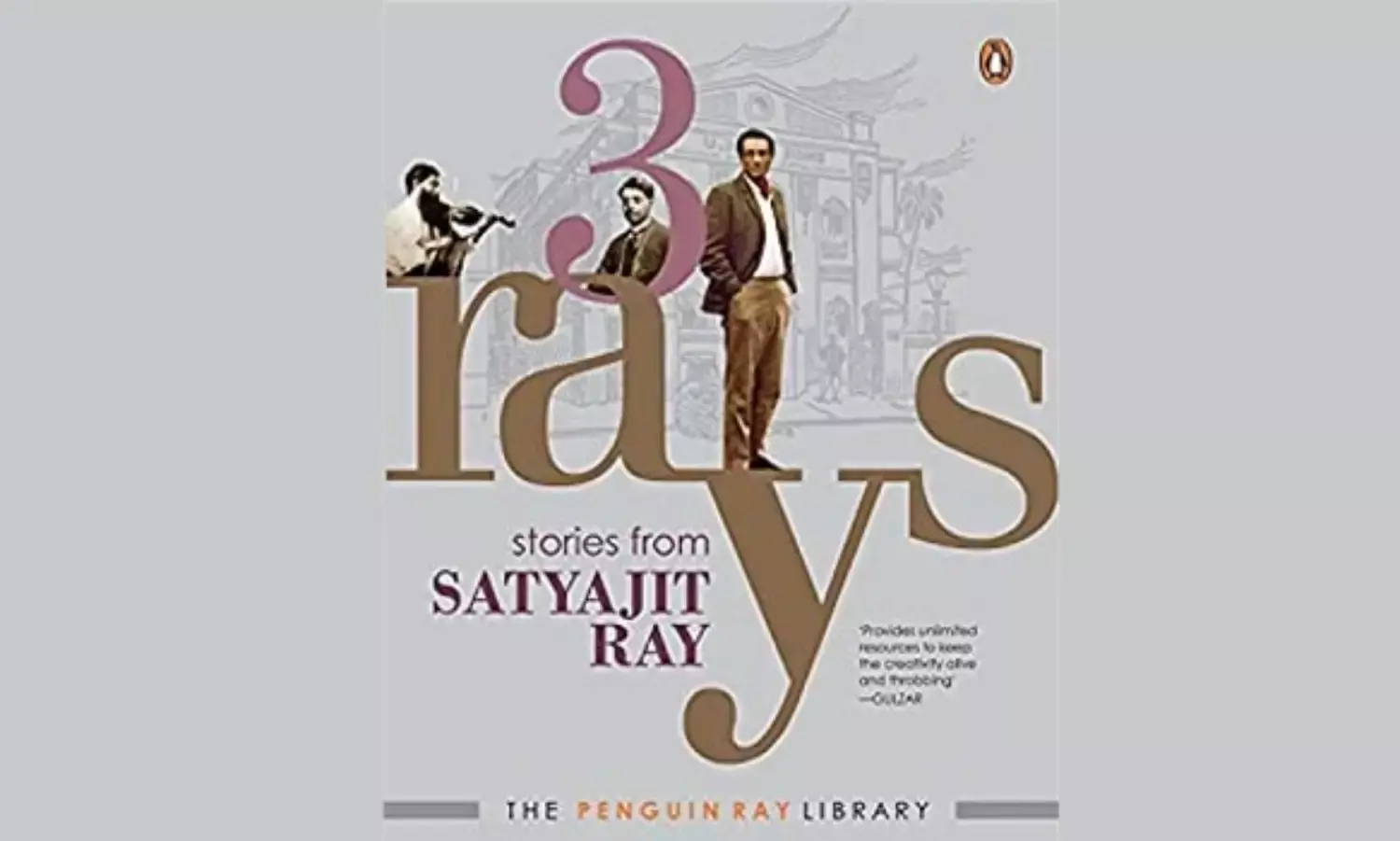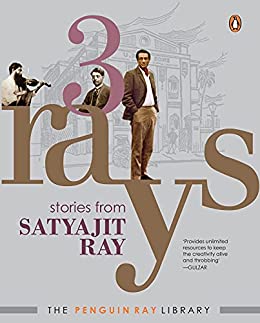3 Rays - A Priceless World in 474 Pages
Stories from Satyajit Ray

Born and brought up in Mumbai around the end of World War II, I did not know how to read and write Bengali, my mother tongue, which filled my child-mind with guilt because both my parents almost swam in Bengali literature. My father had an enviable personal library accessible by all who wished to read. Many did not bother to return the books they had borrowed but that did not bother my father.
When I was around ten, I asked my mother to teach me Bengali. She taught me the alphabets through Borno Porichoy – two parts which are not antiquities in the book market today, created by Ishwar Chandra Vidyasagar. This was followed by Sahaj Path in four parts beautifully illustrated with wood-cut prints and written by Rabindranath Tagore.
By then, I was addicted to Bengali language and literature and the direct shift in books came in the form of Tuntunir Boi, a legendary collection of short stories with animal and bird characters taking precedence over humans. At the time, I had no clue about the author and later learnt they were written by Upendrakishore Roy Choudhury, the grandfather of Satyajit Ray.
Seven of the stories translated into English by Satyajit Ray find place in the monumental piece of work 3 Rays – Stories from Satyajit Ray, published by Penguin in its new series The Penguin Ray Library.
This priceless compilation has been edited by Sandip Ray who has contributed an enlightening foreword to the book co-edited by Riddhi Goswami with the layout and design plus the Vector illustration of Ray’s portrait on the half-title page of the book by Pinaki De, considered one of the most prized and best graphic designers and cover design artists in the publishing world today.
Readers born around the 1950s, 1960s and even into the 1970s still find great delight in reading all the stories in Tuntunir Boi not once but again and again, in original Bengali, revelling in the intelligence of a little bird called Tuntuni and the most popular story being Majantali Sarkar, a cat whose arrogance was reduced to a degree that led to his death. These stories take us back on a nostalgic trip to our childhood.
3 Rays – Stories from Satyajit Ray is a tome that runs into 474 pages. Because of the soft binding, the thickness makes reading somewhat challenging but the substance of each story keeps you hooked plus the pages have an old-world smell that takes us back to our childhood days.
Following a foreword by the fourth generation Ray – Sandip, the books is divided into four parts – Satyajit Translates Upendrakishore which includes the original story of Goupy Gyne Bagha Byne authored by Upendrakishore followed with Film Treatment of Guopy Gyne Bagha Byne done by Ray himself when he adapted his grandfather’s story into film.
The second part is titled Satyajit Translates Sukumar comprising fifteen translations of Sukumar Ray’s nonsense verses from Abol Tabol, Ha Ja Ba Ra La and so on all done by his eminent son. This includes one translation done by Satyajit called Sukumar which is the translation of a Bengali essay Amar Baba written and read by Satyajit Ray as a radio talk broadcast by All India Radio, Calcutta, in July 1977.
It has been translated into English by Indrani Majumder. In this essay, at one point, Ray laments “One major regret in my life is that I never got to see the original illustrations of Ha-Ja-Ba-Ra-La. No one knows its whereabouts along with the original illustrations produced for Abol Tabol and Ha-Ja-Ba-Ra-La.”
His main lament is that since he lost his father when he was hardly two-and-a-half, he began to understand his father through the latter’s drawings, writings, notes, draft pages and manuscripts.
Some all-time favourite nonsense rhymes translated by Satyajit find place in the book. Among them are The Old Woodman (Kath Buro), originally published in 1915, Stew Much (Khichuri) originally published in 1915, The Missing Whiskers (Gonf Churi) published in Sandesh in March 1915, The Sons of Rangaroo (Ramgorurer Chana) published first in Sandesh in May 1918 and which has now become common slang to describe people who never smile! Satyajit has adhered to the rhyming style even in the English translations.
Satyajit Translates Satyajit forms part three of the book which, after an introduction by Ray himself, contains 19 translated works of his own writings from Bengali to English following an introduction. In this introduction (published as Introduction in a compilation titled Stories (Secker & Warburg, 1987), Ray goes back to 1913, much before he was born, where he tells us about how his grandfather launched a children’s monthly magazine called Sandesh.
This magazine, with children and teenagers as its target audience, has been running for four generations of the Rays, the fourth being Satyajit Ray’s son Sandip Ray who began publishing it after it had stopped for a few years. Ray describes how, after he along with his poet friend Subhash Mukhopadhyay, revived Sandesh in 1961.
If Sandesh had not been revived and had not Ray felt his urgency to contribute creatively with stories along with his own illustrations, his wonderful short stories, sketches or even his internationally celebrated fictitious detective Feluda would not have seen the light of day.
Among the stories, a few of which I had read in the original, the one I loved the most is The Small World of Sadananda. This story was originally published in Sandesh (October 1962) as Sadanander Khude Jagat. The English translation by Ray was published in Target, annual number 1988, as The Little World of Sadananda. The story is about a 13-year-old boy Sadananda who creates an unusually emotional bond with a little ant which teaches him, indirectly, the value of solidarity.
The last part comprises two of Satyajit Ray’s original stories in English. The first of these two, Absraction, was published in the Sunday Amrita Bazar Patrika, on May 18, 1941. The other story is titled Shades of Grey published in the Sunday Amrita Bazar Patrika on 22nd March, 1942. These two stories are probably being read for the first time by most readers.
The only lament this critic bears about this precious book is that it does not contain even a single story from Sukumar Ray’s collection of school stories under the title Pagla Dashu of which, an early edition was brilliantly illustrated by Satyajit Ray himself.
It is a biting satire on the education system, on the wrong tilt towards academic brilliance with small sketches of incidents in school expressed with a wonderful sense of humour.
Pagla Dashu, who happens to be the protagonist, pretends to be a crackpot and under the guise of being eccentric, he manipulates things so brilliantly that he turns out to be a winner each time, shedding light on the wrong stress on academic excellence at the cost of a strong sense of humor, intelligence and satire.
The textual matter is just half the story about this book. It is a very painstakingly researched work of art, craft and literature as it unfolds the history of every single piece of writing, with a foreword, origin including information about the illustrations of the story and the Bengali calligraphy in the headpiece or, even the end piece illustrations in the stories picked from Ray’s personal collection of woodblocks, the musical notations of the opening song from Goupy Gyne Bagha Byne, the sketches of the ghosts and so on.
Then, there are illustrations of Sandesh right from the original logo created by Upendrakishore gradually evolving into the modern covers of Sandesh designed by Satyajit himself.
The book makes one wonder why Satyajit Ray did not write a book on time management. One wonders also how he combined the creative multi-tasking of making films, including writing the screenplays and composing the music for them, doing illustrations not only for his own writings in Sandesh and other magazines writing short stories and novels, and not to forget his knowledge of the roads, lanes and bylanes of the city of Calcutta that generously dot his stories.
To make a long story short, 3 Rays – Stories from Satyajit Ray is an encyclopedia that sheds extra-ordinary light on the extraordinary lives of three generations of a Bengali family that has left its footprint on the sands of cultural time across the world map.




